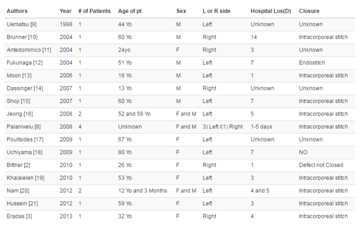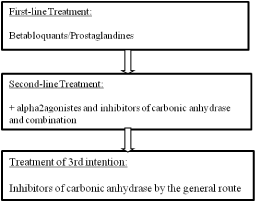Editorial
The National Strategy for the Control of Chronic Glaucoma
Jaouad Hammou*
Department of Ocular and Otological Diseases, Epidemiology and Disease Control Directorate, Ministry of Health,
Rabat, Morocco
*Corresponding author: Jaouad Hammou, Department of Ocular and Otological Diseases, Epidemiology and Disease Control Directorate, Ministry of Health, Rabat, Morocco
Published: 24 Apr, 2017
Cite this article as: Hammou J. The National Strategy for
the Control of Chronic Glaucoma. Ann
Clin Case Rep. 2017; 2: 1342.
Editorial
Chronic glaucoma, with its risk of irreversible blindness, is one of the major public health
problems in Morocco and the world. Its identification, because of the almost asymptomatic nature
of the disease, is the first if not the only means available to control it or at least to act when there is
still time, so as not to become blind without realizing it [1-7]. It is also important to point out that
glaucoma has some specificities in relation to its definition since there are several forms of glaucoma
(glaucoma), the difficulty of making an early diagnosis (insidious and asymptomatic disease), the
means of Diagnosis and therapeutic means (medical: observance and cost, surgical: difficult to
accept by the patient) [1-4,6,8-10].
In this regard, the Ministry of Health developed the national chronic glaucoma strategy
following a national consensus that standardized and standardized concepts related to the definition
of chronic glaucoma, its identification, Diagnosis and therapeutic management in relation to the
national health care system.
This workshop provided answers to five key questions, which are as follows:
1. How is a case of chronic glaucoma defined?
2. What are the risk factors to look for?
3. What is the target population?
4. What are the measurement tools for case identification and diagnosis?
5. How can we identify and manage a case of chronic glaucoma in relation to the health care
system?
Definition of a case of chronic glaucoma [1,3,4-6,8-12]
Chronic glaucoma is defined as bilateral, insidious and progressive chronic optic neuropathy
characterized by:
• Pathological papillary excavation
• A characteristic alteration of the Visual Field (CV)
• Generally associated with ocular hypertonia
Description of the risk factors to be used to define the target population [3,4,10,11-21]
While the causes of increased IOP remain unclear, risk factors for glaucoma development are
well known. It is better to be attentive, especially as their effects tend to be cumulative.
The risk factors used in the national strategy are as follows:
1. Age over 40 years
2. Familyhistory of glaucoma
3. Strongmyopia
4. Use of long-term corticosteroid
5. Diabetes
6. Vascularfactors (hypertension, .........)
7. Eye trauma
8. Melanoderma (dark skin)
This set of factors has been categorized into two groups to define
a suspect case and hence the population at risk.
Factors of major risk
• Age over 40 years
• Familyhistory of glaucoma
Risk Factors Minor
• Strongmyopia
• Use of long-term corticosteroid
• Diabetes
• Vascularfactors (hypertension, .........)
• Eye trauma
• Melanoderma (Black skin)
The population at risk
At least 2 factors of Minor risk
A person at risk is considered a person who
• Familyhistory of glaucoma
• Age over 40 years
Identification of measurement tools: screening and diagnosis of
chronic glaucoma:
Chronic glaucoma is considered to be any person having
1. a pathological papular excavation in the fundus of the eye
(FO)
2. a characteristic visual field image (CV)
3. ocular hypertonia >21 mm Hg (PIO) +/-
Management of chronic glaucoma in relation to the care pathway
(Table 1)
Therapeutic management of chronicglaucoma traitement médical
The national strategy to fight blindness caused by chronic
glaucoma advocates an algorithm for therapeutic decision-making,
starting with monotherapy (a betablocker or a prostaglandin) by local
route. Depending on the course of the disease and the effectiveness
of the treatment, the protocol may be changed to dual therapy, triple
therapy or a change in the route of administration of the medicinal
products or even to other therapeutic options (Flow Chart) [1-4,8-
10].
Surgical treatment
Indications for surgical treatment
• Evolution of the disease (degradation)
• Failure of medical treatment
• No compliance of the patient with the treatment
Table 1
Flow chart
Conclusions
Glaucoma has become an increasing public health problem. About 2.2% of the Moroccan population suffers from this silent disease. It is the second cause of blindness in Morocco after the cataract [1,5,13,25]. In the less developed countries, glaucoma is second only to the causes of blindness (12%) after cataract (50%). In 2002, the number of blind people per glaucoma in the world was estimated at 4.5 million and in 2010 was over 8 million [6,26]. Currently, ophthalmic health facilities have the tools to identify people at risk and diagnosis, including intraocular pressure, fundus and visual field.
References
- Le glaucome, Pr Jean-Philippe Nordman – Pr Philippe Dénis.
- Les glaucomes – volume1, Pr Alain Béchetoile.
- Flament J. Masson. Pathologie du système visuel. Ophtalmologie. 2002: 219-247.
- Mandava S, Sweeney T, Guyer D. Atlas de poche en couleur d'ophtalmologie. FLAMMARION. 2001;238.
- EL Alloussi T, Hammou J, Berraho A. Epidémiologie du glaucome primitif à angle ouvert. Espérance médicale. 2006;13(127):236.
- Prévention de la cécité et des déficiences visuelles – Organisation mondiale de la Santé (site web oms).
- Maurin JF. 100 Images en ophtalmologie [cederom]. EMG. Prod.: Medi Media, 1996.
- Glaucome: Guide pour le patient, Pr Josef Flammer.
- D'aprés le Pr Alain BECHETOILLE (PARIS): Ouvrage: Les glaucomes (T1 et T2): Japperenarded. Fiche Glaucome pratique N°20 (Chauvin ed): Qualité de Vie du Glaucomateux
- Haute Autorité de santé France - Service évaluation médico-économique et santé publique. 2006.
- Denis P, Nordmann JP, Sellem E. GlaucomeScan Guide interactif du diagnostic clinique du glaucome [cederom]. Allergan, 1999.
- Mandava S, Sweeney T, Guyer D. Atlas de poche d'ophtalmologie [texte imprime]. Paris: Flammarion Medecine-Sciences. 2001;1:238-61.
- Prévalence du Glaucome à Angle Ouvert et Facteurs de risques dans une population marocaine à propos de 1182 cas. EL ALLOUSSI T; Berraho A. année académique 2009-2010.
- Tuck MW, Crick RP. The age distribution of primary open angle glaucoma. Ophthalmic Epidemiol. 1998;5:73-83.
- de Voogd S, Ikram MK, Wolfs RC, Jansonius NM, Hofman A, de Jong PT. Incidence of open-angle glaucoma in a general elderly population: de Rotterdam Study. Ophthalmology. 2005;112(9):1487-93.
- Friedman DS, Wolfs RC, O'Colmain BJ, Klein BE, Taylor HR, West S, et al. Prevalence of open-angle glaucoma among adults in the United States. Arch Ophthalmol. 2004;122(4):532-8.
- Le A, Mukesh BN, McCarty CA, Taylor HR. Risk factors associated with the incidence of open-angle glaucoma: the visual impairment project. Invest Ophthalmol Vis Sci. 2003;44(9):3783-9.
- Sommer A. Glaucoma risk factors observed in the Baltimore Eye Survey. CurrOpinOphthalmol, 1996;7:93-8.
- Hennis A, Wu SY, Nemesure B, Leske MC. Barbados Eye Studies Group Hypertension, Diabetes, and longitudinal changes in intraocular pressure. Ophthalmology. 2003;110:908-14.
- Gordon MO, Beiser JA, Brandt JD, Heuer DK, Higginbotham EJ, Johnson CA, et al. The Ocular Hypertension Treatment Study: baseline factors that predict the onset of primary open-angle glaucoma. Arch Ophthalmol. 2002;120(6):714-20.
- Dielemans I, de Jong PT, Stolk R, Vingerling JR, Grobbee DE, Hofman A. Primary open-angle glaucoma, intraocular pressure, and diabetes mellitus in the general elderly population. The Rotterdam Study. Ophthalmology. 1996;103(8):1271-5.
- Mitchell P, Smith W, Chey T, Healey PR. Open-angle glaucoma and diabetes: the Blue Mountains eye study, Australia. Ophthalmology, 1997;104:712-8.
- Tielsch JM, Katz J, Quigley HA, Javitt JC, Sommer A. Diabetes, intraocular pressure, and primary open-angle glaucoma in the Baltimore Eye Survey. Ophthalmology 1995;102:48–53.
- Lee AJ, Rochtchina E, Wang JJ, Healey PR, Mitchell P. Does smoking affect intraocularpressure? Findings from the Blue Mountains Eye Study. J Glaucoma. 2003;12:209-12.
- Ouertani A, Zhioua R, Trabelsi A, Jrad J. Prevalence of chronic open-angle glaucomain a county in Tunis. J Fr Ophtalmol. 1995;18:178-82.
- Recommendations of EMR Regional Meeting on Development of Public Health Approaches in Management of Glaucoma - regional workshop on the development of public health control strategies in glaucoma. emro, Cairo. 2009;14-16.


